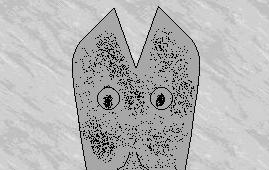by GIDEON GINRACHMANJINJa-VITUS, Alternate Reality News Service Economics Writer
Multi-millionaire musician/entrepreneur Dominic LePeletonne has been charged with fraud in connection with sales of his breath to the public.
“Actually,” Milton Harlooney-Toonian, professor of XTreme Economics at Waterloo’s famed Lack of Boundaries Institute, cavilled, “he was selling ownership of his breath to the public.”
“Actually,” Hildebrand Grump, a performance artist and author of Occupying the Empty Space and Emptying the Occupied Space: My Life Doing Stuff, cavilled…doubled, “he was selling the idea of ownership of his breath to the public.”
Oh, boy. Looks like I got some ‘splainin’ to do!
LePeletonne made his first million dollars as a member of the French boy band Les Gigglieo Gigolos. (For North American readers, the band had a huge European hit with the single “Foufrou l’Orangutan (Size Twelve),” which took America by raindrop.) He had steadily grown his small fortune into a slightly larger fortune over the course of the next decade. Then, he discovered NFTs.
NFTs, known more fully as Netherworld Frankincense Territories, are –
“That’s not what NFT stands for,” Harlooney-Toonian triple cavilled…with a twist (he was drinking a vodka and horse tranquilizer while speaking through a ventriloquist’s dummy).
You got me. NFTs, which actually are known more fully as Nurturing Flourescent Tumescences are –
“Nope. That’s not what NFT stands for,” Grump quadruple cavilled (and was only given a 3.2 score by the Flemish judge – bastard Flemingos!).
Okay, okay. NFTs, Non-Fungible Tokens, are – that is to say you can use them to – umm, help me out, here, guys?
Harlooney-Toonian sighed dramatically. “Non-Fungible Tokens are certificates that attest to the fact that you are the owner of a unique object,” he explained. “Using blockandtacklechain technology, the certificates can only be owned by one person and cannot be copied. What LePeletonne did was -“
Thanks. I can take it from here. What LePeletonne did was breath into canisters, seal them and sell NFTs attesting to their uniqueness to people who wanted a piece of musical history. The canisters were made of steel so the unique molecular configuration of each breath could not escape for several thousand years. The 100,000 canisters (sold for 10,000 Euros each or four for 50,000 Euros) were kept in a temperature controlled vault built into the side of a mountain (the one next door to the one Buckaroo Banzai drove through).
That would have been a legitimate product save for one thing: each certificate claimed that the breath was taken on July 27, 2024. But, anybody who tried to exhale 100,000 times in a single day would quickly hyperventilate and pass out. It turns out that LePeletonne paid prisoners in China to breath into the canisters and claimed that he did all the work.
That’s the textbook definition of fraud. Well, if the textbook had been written by William S. Burroughs.
“It was shocking!” Harlooney-Toonian grumped. “Selling one thing but delivering another is for advertisers in the backs of comic books and conservative politicians, not millionaire musician/entrepreneurs!”
“It was exhilarating!” Grump Harlooney-Toonianed. Figuratively speaking. “It laid the whole consensual reality that is the economic system bare! Adam Smith should have sued William Gibson for copyright infringement!”
Two months after this revelation, LePeletonne’s reputation was further damaged when it was discovered that he had created downmarket NFTs for people who couldn’t afford the original line: for a mere 1,000 Euros, one could buy an NFT representing a beaker containing his saliva; for 100 Euros – a steal at twice the price1 – one could buy an NFT representing a test tube containing his pee. The beakers and test tubes were kept in a secure storage shed out back of his mansion.
Harlooney-Toonian moaned. “This doesn’t change a thing,” he insisted, although his heart was far north of his voice. “When properly managed, NFTs are an important development in the theory and practice of economics.”
Grump laughed. “This doesn’t change a thing,” he agreed, although he was actually making a diametrically opposed point.. “The theory and practice of economics has always been a case of two ships colliding in the night and not enough door space floating in the wreckage to save everybody – this is just the latest example.”
LePeletonne refused to respond publicly to the allegations – his answering machine sneered at me when I tried to contact him – but his publicist did stare wistfully at a daisy he held in front of him and said, “What is money, anyway? Does anybody money anybody anyway?”
I’m pretty sure that’s not how the song goes, but I’m up against a ridiculous deadline, so I’ll have to leave that issue to a follow-up report.

